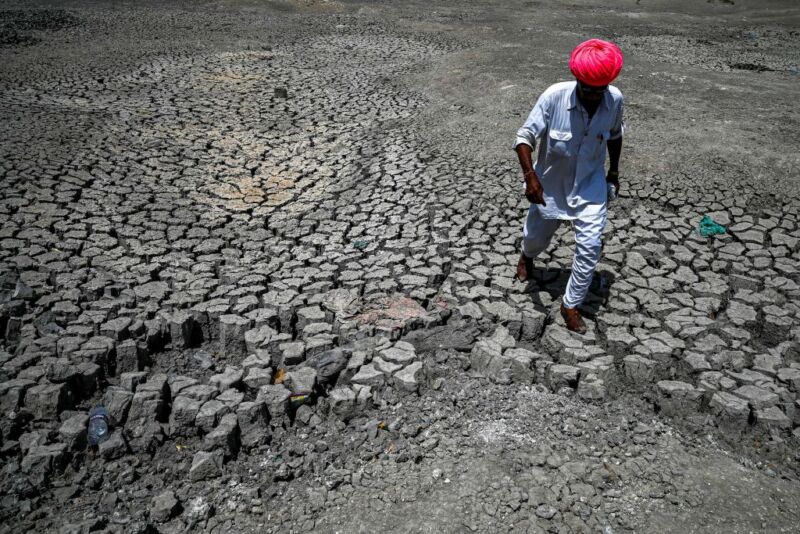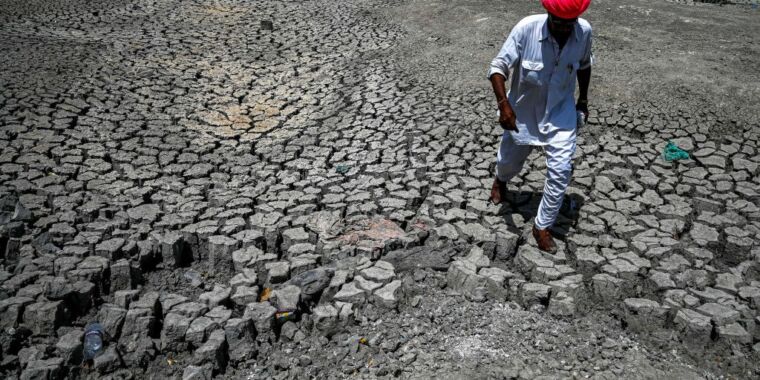
Prakash Singh | Getty
R Lakshmanan has been making steel frames in the southern Indian city of Chennai for 20 years. His job involves standing for long hours outdoors at construction sites, pounding screws with careful precision onto steel rods. Each day he makes nearly 600 frames, which end up becoming the skeleton of a home. Often he works 12-hour shifts, beginning at 6 am. He always feels fortunate when he gets to work under a shady tree.
But this year, that protection hasn’t been enough. Ever since temperatures in March hit a sizzling 38° Celsius—4° above normal for Chennai—the conditions have been stifling. The metal frames Lakshmanan works with have been too hot to touch, the steel burning his fingertips and leaving behind painful sores. He has seen construction workers, especially women, collapse around him, and has had to take breaks during the workday to cope with fits of dizziness and nausea. “On some days, there’s so much heat, it feels like you’re living in a fireball,” he says.

When faced with these conditions, our bodies call upon a well-known mechanism to keep us from overheating: sweating. As perspiration evaporates from the skin, it cools the body’s temperature. But if the air is not only hot but also already filled with moisture, less sweat can evaporate, and this safety feature fails. In India, high temperatures and humidity are increasingly combining to pose a deadly threat—one the country isn’t prepared for.
This danger to human life is measured using “wet-bulb temperature”—the lowest temperature that air can be cooled to via evaporation. It’s determined by wrapping the bulb of a thermometer in a wet cloth and seeing what temperature is recorded. Essentially the bulb is you—or me, or Lakshmanan—the wet cloth is our sweating skin, and the temperature recorded is the coolest we can hope to get by sweating.
When heat and humidity combine to push wet-bulb temperatures past 32° Celsius, physical exertion becomes dangerous. Consistent exposure to high wet-bulb temperatures—35° Celsius and above—can be fatal. At this point the sweating mechanism shuts down, leading to death in six hours. On May 1, 2022, the wet-bulb temperature in Lakshmanan’s home city of Chennai hit 31° Celsius. The same day, the district of Ernakulam in the Indian state of Kerala recorded a wet-bulb temperature of 34.6° Celsius—a record high for the area.
“Without the mechanism to rid the body of that excessive heat, there are many physiological changes that happen in quick succession,” says Vidhya Venugopal, a researcher in public health at the Sri Ramachandra Institute of Higher Education and Research in Chennai.
Raise your internal temperature by 3° to 4° Celsius, and you’ll start to struggle. “As the body tries hard to restore your core temperature, all other processes slowly grind to a halt,” Venugopal says. Blood vessels dilate and circulation slows, particularly to the extremities. Not enough blood will flow to the brain, affecting its functioning. You lose alertness, become drowsy, and don’t feel thirst anymore. Soon organs shut down, one by one. “When the brain stops giving messages to the heart, the pulse slows and the person goes into a coma,” she says.
“Humidity aggravates the killing power of heat,” says Ambarish Dutta, professor of epidemiology at the Indian Institute of Public Health in Bhubaneswar. “It can trigger catastrophic events like heart attacks and strokes, aggravate secondary conditions like diabetes, change the regulatory capacity of the kidneys, affect the endocrine system by triggering stress hormones. In short, it’s a silent killer.”
World Weather Attribution, an international collaboration that analyzes extreme weather events, estimates that India and Pakistan’s recent heat wave has led to at least 90 deaths across both countries. During India’s 2015 heat wave, wet-bulb temperatures in the southern state of Andhra Pradesh rose to 32° Celsius. That year, the heat killed over 2,500 people.
Such events are going to become increasingly common as climate change warms the world. What magnifies the problem is that as temperatures rise, so does the absolute humidity in the atmosphere, says Jane Baldwin, assistant professor in the Department of Earth System Science at the University of California, Irvine. Thanks to what’s known as the Clausius–Clapeyron relationship of thermodynamics, “for every 1° increase in temperature, you see a 7 percent increase in humidity,” she explains. It means that for countries like India, climate change has a compounding impact. The effect is strongest over the world’s oceans, and particularly the Indian Ocean, whose rapid warming is a big trigger of South Asia’s high wet-bulb temperatures.








